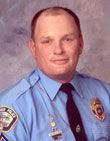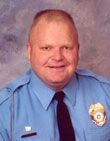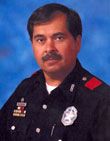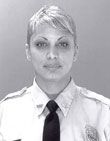Editor’s note: This article was published in the May 2009 issue of AMERICAN POLICE BEAT, a national law enforcement publication. It has been reprinted on PoliceOne with permission of the author and AMERICAN POLICE BEAT.
By Craig W. Floyd
 Sergeant William Biggs Jr. Kirkwood (MO) Police Department  Officer Thomas Ballman Kirkwood (MO) Police Department |
According to Mike Prosperi, owner of the Imo’s Pizza near City Hall, everyone in Kirkwood (MO) knew Charles Lee “Cookie” Thompson. “He always had a smile on his face,” according to Mr. Prosperi, and “he was always saying, ‘God bless you.’”
But there was another side to Thornton. He was a regular presence at City Council meetings, and he was not there to listen quietly. A newspaper correspondent, Janet McNichols, who covered those Council meetings, said Thornton would “come to the meeting and he’d have a big easel and a picture of a donkey on there and call the Council asses.” He had twice been convicted of disorderly conduct for disrupting Council meetings, and a federal judge had recently dismissed a lawsuit filed by Thornton claiming that his free speech rights had been violated because he was prohibited from speaking out at meetings.
Doug Vaughn, an acquaintance of Thornton’s, said, “He was more than a critic. It got to where he was showing up at every Council meeting and trying to dominate everything. He kind of lost his mind.”
On the evening of February 7, 2008, Thornton left a note for his brother saying, “The Truth will win in the end,” and then he made his last trip to City Hall. Armed with a large-caliber revolver, he confronted 20-year police veteran William K. Biggs, Jr., outside of City Hall and opened fire. After killing Sergeant Biggs and stealing his weapon, Thornton then burst into the City Council meeting where about 30 people had just recited the Pledge of Allegiance.
His first target there was another Kirkwood police officer, Thomas Ballman, 37, who was shot and killed before he could draw his weapon. Thornton then continued screaming and shooting. In the horror-filled moments that followed, three more city officials were killed, and two others were seriously injured, including Kirkwood Mayor Mike Swoboda, before responding officers shot and killed Thornton.
Sergeant Biggs’s son, Bo, said of his father, “Some days he wore the uniform and other days he didn’t, but he was always a police officer . . . if someone needed help he was there.”
A former police dispatcher described Tom Ballman as a man who “exercised integrity in everything he did. There are just certain people you feel are the best of the best.”
Sergeant Biggs and Officer Ballman were two of the 133 federal, state and local law enforcement officers killed in communities across America last year. All of their names were officially added to the National Law Enforcement Officers Memorial in Washington, DC, at the annual Memorial candlelight vigil on May 13. With those names added, along with 254 newly discovered line-of-duty deaths from earlier years, there are now 18,661 names inscribed on the Memorial walls.
While the personal tragedies behind each and every one of those names can never be diminished, there was one glimmer of good news hidden in the fatality figures from 2008; fewer law enforcement lives were lost in 2008 than in any year since 1960, when 127 officers made the ultimate sacrifice.
For the 11th straight year, traffic-related incidents claimed the lives of more officers (71) than any other cause of death. Forty-four of those officers died in automobile crashes, 18 were struck and killed by vehicles and nine died in motorcycle crashes. Among that latter group was Dallas Police Corporal Victor Antonio Lozada, Sr., who was killed in a motorcycle crash on February 22 while escorting Presidential candidate Hillary Clinton’s motorcade. Corporal Lozada was also one of 14 Texas law enforcement fatalities last year, the most for any state.
 Corporal Victor Lozada Sr., Dallas Police Department  Officer Isabel Nazario, Philadelphia Police Department |
Thirty-nine officers were killed by gunfire, which was the lowest number of firearms-related fatalities since 1956, when 35 officers were shot and killed. Among the other causes of death, 13 died of job-related illnesses, two were killed in a helicopter crash, two died in a bomb explosion, one was killed in an airplane crash, one officer was beaten to death, one officer drowned, one was electrocuted, one was stabbed to death, and one officer was killed in a train crash.
On average, the officers who sacrificed their lives were 39 years old and had served for 12 years. The two youngest officers—both 22—were Evangeline Parish (LA) Deputy Sheriff Jeremy Carter, who collapsed and died on December 19 during the foot pursuit of a burglary suspect; and Jose Rivera, a Federal Bureau of Prisons correctional officer, who was stabbed to death on June 20 by two inmates at a California penitentiary.
Officer Rivera was also one of four correctional officers to make the supreme sacrifice in 2008. The others were New York City Correctional Officer Kenny Duncan, Arizona Correctional Officer Douglas E. Falconer, and Alabama Correctional Officer Rodney Kelley.
The oldest officer to die in 2008 was William K. Chadwell, a deputy sheriff with the Pickaway County (OH) Sheriff’s Office. On Christmas Eve, the 70-year-old deputy was clearing a fallen tree from the road when he was struck and killed by a vehicle.
Six of the officers killed in 2008 served with federal agencies, compared to 17 federal fatalities in 2007. Thirteen of the fatalities last year were women, making 2008 the third deadliest year in history for female officers. Only 2002 with 15, and 1998 with 14, had more. Among the female officers who had their lives taken in 2008 was Isabel Nazario, a Philadelphia police officer who was killed when her patrol car was struck by a stolen vehicle driven by a 16-year-old boy. Officer Nazario was one of four Philadelphia officers killed in 2008, the most of any single agency.
On August 26 of last year, Montana State Trooper Evan F. Schneider, 29, was attempting to stop a vehicle for a traffic violation when he was killed in an auto crash. At his funeral, the head of the Montana Highway Patrol, Colonel Paul Grimstad, related the story of Trooper Schneider’s initial job interview some five years earlier. Trooper Schneider was asked why he wanted to join the Highway Patrol. “Evan said he wanted to work with the good people,” recalled Colonel Grimstad. “To this day, that answer makes my job worthwhile.”



